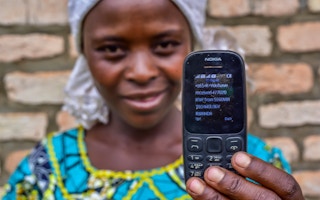United States-based nonprofit group GiveDirectly recently disclosed a nearly US$1 million fraud scheme involving one of its cash transfer aid programmes in the Democratic Republic of the Congo (DRC).
Direct cash transfers are gaining popularity as a form of aid for low-income populations, particularly in developing countries.
Here’s what you need to know about the case and how it has stirred debate about cash transfers compared to traditional forms of aid:
How did the fraud occur?
The group calculated that about US$900,000 was stolen over the course of six months, diverting aid from more than 1,700 families in extreme poverty.
GiveDirectly uses mobile money transfers through SIM cards registered to a government ID and protected with a code.
According to the group’s statement, while enrolling villages in South Kivu some staff ended up pocketing the registered SIMs and putting different ones in the phones of the intended recipients.
The group acknowledged that it had skipped a usual safeguard in its protocol of using independent mobile money agents because of the dangerous conditions in the region – a perennial issue in many areas with vulnerable populations.
It added that the perpetrators had recruited local staff “in every layer” of its fraud prevention system and that outsiders, including mobile money agents and former staff, were involved in the scheme.
To what extent are cash transfer programs more susceptible to fraud than other forms of aid?
Particularly in areas of conflict, there is always risk for armed groups or other bad actors to intercept aid – whether food or cash assistance, said Chris Blattman, a professor at the University of Chicago and an expert on global conflict.
“You’re working in weakly institutionalised states; there’s a pipeline of cash going in and relatively poor and middle-income people see ways to slice a little bit off of that,” he said. “And so it’s challenging to overcome.”
Many governments around the world raced to stand up cash aid programmes to respond to the Covid-19 pandemic – sometimes without proper checks and safeguards.
Kenya’s pandemic cash programme ended up leaving out many vulnerable residents as government officials were allegedly steering the funds to their friends and family, according to a 2021 report from Human Rights Watch.
But cash transfer proponents argue that such programmes are still the most efficient way to deliver aid and, given proper safeguards, can be more secure than other methods like food assistance.
“Honestly, anonymous cash going to your mobile account that nobody sees being delivered is possibly the best way,” Blattman said. “It’s actually quite reasonably the hardest thing to get shaken down for.”
The same week GiveDirectly disclosed the fraud, the UN World Food Programme (WFP) and the US announced they were suspending food aid to Ethiopia out of concern over widespread theft of donations.
“In many ways, cash is actually less risky because you have fewer middlemen,” said Lynn Yoshikawa with the CALP Network, a group of organisations that works on cash assistance issues.
“A lot more cash is delivered digitally in the form of mobile money and cards – it’s a lot more traceable … if this were a food aid programme, that would probably be a lot harder to track what went where.”
What other risks or drawbacks exist in cash transfer programmes?
Identifying which populations will receive the aid can be tricky. Among criteria such as poverty indexes, GiveDirectly has relied at times on factors including whether a house has a thatch or metal roof to determine recipients – while acknowledging shortcomings with such methods.
“It’s capricious, right? I mean, some people are getting the money and other people aren’t. And it’s not because some of them are morally worse or morally better – it’s random chance,” said Charles Kenny with the Center for Global Development, a Washington and London-based nonprofit.
Some studies have concluded cash transfer programmes help reduce incidents of domestic violence, though there is still debate on that issue.
“The evidence is very mixed, but it does seem that under some circumstances, if the payment goes directly to the woman it can increase risk of domestic violence because the man wants the money,” Kenny said.
What can other aid groups learn from the GiveDirectly case?
GiveDirectly should be given credit for publicly disclosing the case, Yoshikawa said.
“What the GiveDirectly incident speaks to is that these bad actors had to go through a lot more effort, actually, to succeed in their diversion efforts,” she said, adding that it was a reminder about the need for mitigation measures.
Kenny said it should not deter organisations from working to benefit people in places prone to crime and weak institutions.
“Definitely what the lesson not ought to be is we’re going to give up working in the hardest places,” he said.
This story was published with permission from Thomson Reuters Foundation, the charitable arm of Thomson Reuters, that covers humanitarian news, climate change, resilience, women’s rights, trafficking and property rights. Visit https://www.context.news/.

















